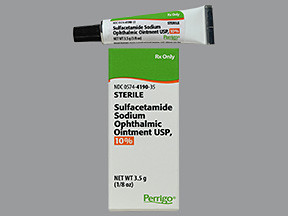SULFACETAMIDE OINTMENT - OPHTHALMIC
PHONETIC PRONUNCIATION: (SUL-fa-SEET-a-mide)
COMMON BRAND NAME(S): Cetamide
GENERIC NAME(S): sulfacetamide sodium
Uses
USES: This medication is used to treat bacterial eye infections (such as conjunctivitis). It belongs to a class of drugs known as sulfa antibiotics. Sulfacetamide works by stopping the growth of bacteria. This medication treats only bacterial eye infections. It will not work for other types of eye infections. Unnecessary use or misuse of any antibiotic can lead to its decreased effectiveness.
How to use SULFACETAMIDE OINTMENT - OPHTHALMIC
HOW TO USE: To apply eye ointment, wash your hands first. To avoid contamination, be careful not to touch the tip of the tube or let it touch your eye or any other surface. Apply to the eyes only. Do not swallow or inject. Do not wear contact lenses while you are using this medicine. Sterilize contact lenses according to manufacturer's directions, and check with your doctor before you begin using them again. To apply eye ointments, tilt your head back, look up, and gently pull down the lower eyelid to make a pouch. Place a half-inch (1.3 centimeters) strip of ointment into the pouch. Gently close the eye and roll the eyeball in all directions to spread the medication. Try not to blink and do not rub the eye. Use as directed by your doctor. Repeat these steps for your other eye if so directed. Wipe the tip of the ointment tube with a clean tissue to remove extra medication before recapping it. Wait several minutes for your vision to clear before driving or operating machinery. The dosage is based on your medical condition and response to treatment. Your doctor may direct you to use this medication more often at first, then use it less frequently as the infection improves. Follow your doctor's directions exactly. Your doctor may direct you to use sulfacetamide drops during the day and the ointment at bedtime. If you are using another kind of eye medication (such as drops or ointments), wait at least 5 minutes before applying other medications. Use eye drops before eye ointments to allow the drops to enter the eye. Use this medication regularly in order to get the most benefit from it. To help you remember, use it at the same times each day. Continue using it for the full time prescribed, usually 7 to 10 days. Stopping the medication too soon may allow the bacteria to continue to grow, which may result in a return of the infection. Tell your doctor if your condition persists or worsens.
Side Effects
Precautions
Interactions
Overdose
Images
Reviews
Faq for SULFACETAMIDE OINTMENT - OPHTHALMIC
Sulfacetamide Ointment is used for the treatment of eye infections caused by bacteria. It is commonly prescribed for conditions like conjunctivitis, blepharitis, and other bacterial eye infections.
Sulfacetamide Ointment works by inhibiting the growth of bacteria that cause eye infections. It belongs to the class of drugs known as sulfonamides, which have antibacterial properties.
First, wash your hands. Then, tilt your head slightly back and pull down your lower eyelid to create a small pocket. Squeeze a small amount (around 1/2 inch) of ointment into the pocket. Close your eyes gently and move them around to spread the ointment. Avoid touching the tip of the tube to prevent contamination.
Typically, Sulfacetamide Ointment is applied 2 to 3 times a day. Follow the instructions provided by your doctor or pharmacist. Do not use more or less than recommended by your healthcare professional.
If you miss a dose, apply it as soon as you remember. If it is close to the time for your next scheduled dose, skip the missed dose and continue with your regular dosing schedule. Do not apply extra ointment to make up for the missed dose.
Common side effects may include temporary stinging or burning sensation, temporary blurred vision, and eye irritation. These side effects are usually mild and go away on their own. However, if you experience severe or persistent side effects, contact your doctor.
It is generally recommended to avoid wearing contact lenses while using Sulfacetamide Ointment. The ointment may interact with the lenses and cause discomfort. Consult your eye care professional for more advice.
You should use Sulfacetamide Ointment for the full course of treatment as prescribed by your doctor, even if your symptoms improve. Do not stop using the ointment prematurely, as it may lead to the recurrence of the infection.
Yes, Sulfacetamide Ointment can be used in children. However, dosage and administration should be determined by a healthcare professional. It is important to follow their instructions and guidelines.
Disclaimer
IMPORTANT: HOW TO USE THIS INFORMATION: This is a summary and does NOT have all possible information about this product. This information does not assure that this product is safe, effective, or appropriate for you. This information is not individual medical advice and does not substitute for the advice of your health care professional. Always ask your health care professional for complete information about this product and your specific health needs.

No Reviews Yet